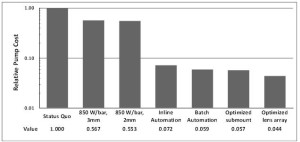By Dominic Siriani
In the same way as I began yesterday’s entry, I’d like to congratulate those honored at today’s CLEO plenary session, in this case the new IEEE Photonics Society and OSA fellows. Following the award presentation, Prof. Alan Willner gave an overview of the National Photonics Initiative, which has been created to help raise awareness, increase collaboration, and drive investment in photonics. The takeaway message concluding Prof. Willner’s presentation was to be sure to spread word of the crucial importance of photonics!
To wrap up the plenary session, Dr. Kumar Patel gave an excellent overview of the rapid development and importance of quantum cascade lasers (QCLs) for moderate-power (Watt-class) mid-infrared applications. Dr. Patel described the appealing features of QCLs, including wavelength agility, good efficiency, and reduced size when compared to competing technologies in the mid-IR wavelength regime. Due to these favorable attributes, QCLs are having (and likely will continue to have) significant impacts in the areas of infrared countermeasures, chemical detection, target illumination, and potentially even laser radar and optical communications.
Following the plenaries, I attended the Symposium on High Power Diode Laser Arrays, which essentially was an all-day event. An underlying theme of the symposium was that there is a growing need for a reduction in the cost-per-Watt of high-power diode lasers. This is driven considerably by the need for these lasers as pumps for large-scale laser systems, such as the one required for the Laser Inertial Fusion Energy (LIFE) system at Lawrence Livermore and other comparable systems throughout the world. In addition to a cost reduction, a production increase is a dire need, as the diode laser power needed for LIFE by far exceeds the total current supply.
 Pump diode cost reduction estimates for advances including improvements in power-density-per-bar, manufacturing process, and packaging (Deri, “Engineering diode laser pumps for extremely large scale laser systems,” presented at CLEO, 2013).
Pump diode cost reduction estimates for advances including improvements in power-density-per-bar, manufacturing process, and packaging (Deri, “Engineering diode laser pumps for extremely large scale laser systems,” presented at CLEO, 2013).
The cost-per-Watt of diode lasers is ultimately dictated by a number of factors in the production process, but the agreed-upon solution seems to be to pack in as much power at the low-cost step, individual die production, and to create an automated streamlined process to reduce all other packaging and testing costs. What this means is that one piece of the solution is to produce a large amount of optical power from a single monolithic diode bar or otherwise reduce packaging costs, while simultaneously maintaining high efficiency. The increase in power-per-bar can be achieved by creating very advanced high-power arrays on a single bar. Additional gains can be made in efficiency by using cooling the diode lasers to work in a more efficient temperature range. In addition, closer packing of laser bar stacks can lead to an increase of power per area, which can reduce the amount of needed packaging, increase brightness, and produce an overall increase in pumping efficiency and a reduction in cost. Finally, with a standardized, consistent product need, overall costs can be reduced significantly by enabling a streamlined, automated, and cost-efficient “assembly-line” model for high-power pump diode lasers. However, the sentiment expressed is that it is necessary to get started on this process as soon as possible!
A number of specific measures for achieving these goals were presented in the symposium. I recommend to anyone interested in learning more specific detail to check out the abstracts submitted to the conference and find out more about the exciting work going on in this rapidly expanding area of high-power diode pump lasers.
Disclaimer: Opinions, interpretations, conclusions, and recommendations are those of the author and are not necessarily endorsed by the United States Government and MIT Lincoln Laboratory.
Posted: 13 June 2013 by
Dominic Siriani
| with 0 comments